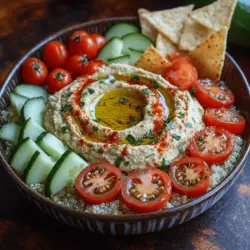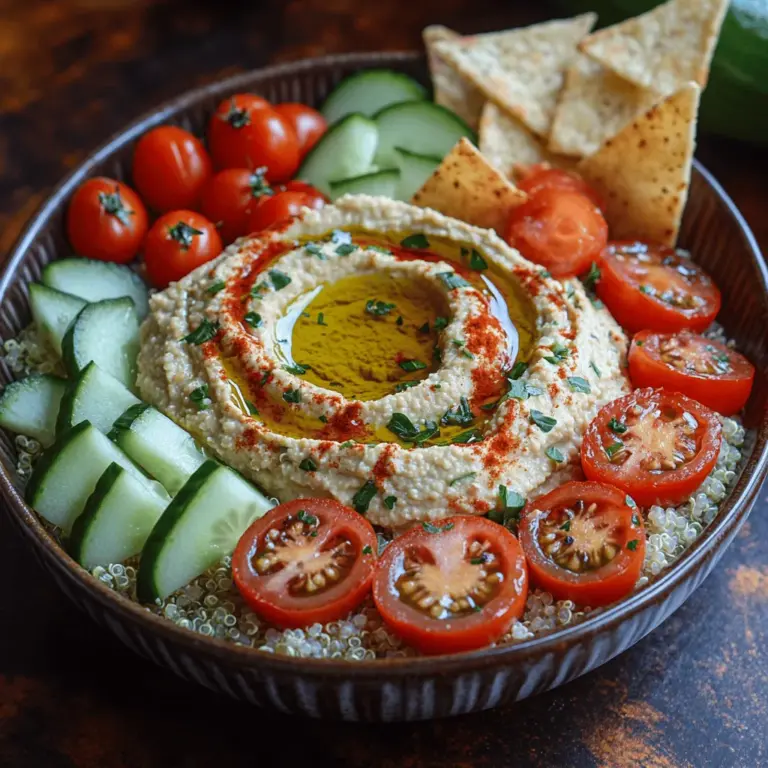Hummus has become a global sensation, celebrated for its creamy texture and rich flavor. Originating from the Middle East, this chickpea-based dip has evolved into various forms, adorned with an array of toppings and flavors that cater to diverse palates. Its versatility makes it a beloved choice in numerous cuisines, from Mediterranean to Middle Eastern and even contemporary American dishes. Among the many ways to enjoy hummus, the innovative concept of hummus bowls has captured the hearts of health-conscious eaters and food enthusiasts alike.
The Versatility of Hummus Bowls
Hummus bowls take the classic dip to new heights by transforming it into a wholesome meal that can be customized to suit any taste preference. These bowls typically feature a base of hummus topped with fresh vegetables, grains, and proteins, creating a visually stunning and nutrient-dense dish. The beauty of hummus bowls lies in their adaptability; whether you’re in the mood for a light lunch or a filling dinner, there’s a hummus bowl for every occasion.
What sets hummus bowls apart is the delightful combination of flavors and textures. With a creamy layer of hummus as the foundation, the addition of crisp vegetables, hearty grains, and a drizzle of olive oil or tahini creates a harmonious balance that is both satisfying and nourishing. They are perfect for meal prep, easy to assemble, and make for an impressive dish when entertaining guests.
Health Benefits of the Ingredients
Hummus bowls are not only delicious but also packed with health benefits. The primary ingredient, chickpeas, is a nutritional powerhouse, providing a great source of plant-based protein and essential vitamins and minerals. Paired with fresh vegetables like cherry tomatoes, cucumbers, and bell peppers, these bowls deliver an array of antioxidants and dietary fiber, supporting overall health and digestion.
Another essential component is healthy fats, often derived from ingredients like tahini or olive oil. These fats are crucial for nutrient absorption and contribute to heart health. The combination of chickpeas, vegetables, and healthy fats makes hummus bowls a well-rounded option for anyone looking to maintain a balanced diet.
In this article, we will guide you through the process of making Roasted Garlic Hummus Bowls that are not only delicious but also visually appealing and highly nutritious. With a focus on fresh ingredients and step-by-step instructions, you’ll be able to whip up this delightful dish in no time.
Understanding the Key Ingredients in Roasted Garlic Hummus Bowls
To create the ultimate Roasted Garlic Hummus Bowls, it is important to understand the key ingredients that contribute to its flavor and nutritional profile. Below, we will delve into each component, highlighting their benefits and significance in this recipe.
Chickpeas: The Protein Powerhouse
Chickpeas, also known as garbanzo beans, serve as the foundation of hummus and are considered a vital part of Mediterranean and Middle Eastern diets. They are rich in protein, making them an excellent choice for vegetarians and vegans seeking to meet their protein needs. One cup of cooked chickpeas provides about 15 grams of protein and 12 grams of dietary fiber, which aids in digestion and keeps you feeling full longer.
Additionally, chickpeas are packed with essential nutrients such as folate, iron, magnesium, and potassium. Their versatility allows them to be used in various dishes, from salads to soups, making them a staple in healthy cooking.
Roasted Garlic: Flavor and Health Benefits
Garlic is a key ingredient in this recipe, providing a robust flavor that elevates the taste of the hummus. Roasting garlic transforms its pungent raw flavor into a sweet, mellow taste that adds depth to the dish. The process of roasting involves slow-cooking the garlic in an oven, which caramelizes its natural sugars and enhances its aroma.
Beyond flavor, garlic offers numerous health benefits. It is known for its anti-inflammatory and antioxidant properties, which can support immune health and reduce the risk of chronic diseases. Furthermore, garlic has been linked to improved heart health by promoting healthy blood pressure levels and cholesterol profiles.
Tahini: The Creamy Component
Tahini, a paste made from ground sesame seeds, is another essential ingredient in hummus. It adds creaminess and a nutty flavor to the mix, making the hummus irresistibly smooth. Originating from the Middle East, tahini is not only delicious but also boasts a remarkable nutritional profile. It is rich in healthy fats, protein, and a variety of vitamins and minerals, including calcium, magnesium, and vitamin B.
Incorporating tahini into your diet can have several health benefits, such as supporting bone health and providing a source of energy. Its unique flavor complements the chickpeas and roasted garlic, creating a harmonious blend in the hummus.
Fresh Vegetables: Adding Color and Nutrition
A colorful array of fresh vegetables is essential for topping your Roasted Garlic Hummus Bowl. Common choices include cherry tomatoes, cucumbers, red bell peppers, avocados, and red onions. Each of these vegetables contributes not only to the aesthetic appeal of the dish but also to its nutritional value.
– Cherry tomatoes are packed with vitamins A and C, as well as antioxidants like lycopene, which is linked to heart health.
– Cucumbers are hydrating and low in calories, making them a great addition to any bowl.
– Red bell peppers are rich in vitamin C and provide a sweet crunch that balances the creaminess of the hummus.
– Avocados add healthy fats and fiber, making the dish even more satisfying.
– Red onions offer a sharp flavor and are also rich in antioxidants, making them a great choice for enhancing both taste and nutrition.
Quinoa vs. Brown Rice: Choosing the Base
When it comes to selecting a base for your Roasted Garlic Hummus Bowl, both quinoa and brown rice make excellent options, each with its own set of nutritional benefits. Quinoa is a complete protein, meaning it contains all nine essential amino acids, making it a perfect choice for those seeking plant-based protein sources. Additionally, quinoa is gluten-free and rich in fiber, vitamins, and minerals.
On the other hand, brown rice is a whole grain that provides a good source of carbohydrates and fiber. It is also rich in magnesium and selenium, contributing to overall health. When choosing between quinoa and brown rice, consider your dietary needs and personal preferences. Both options will complement the hummus beautifully, adding substance to your bowl.
Step-by-Step Guide to Making Roasted Garlic Hummus
Now that we’ve explored the key ingredients and their benefits, let’s dive into the step-by-step process of creating Roasted Garlic Hummus. This section will guide you through the preparation, starting with the gathering of ingredients to the roasting of garlic.
Preparation: Gathering Your Ingredients
Before you embark on your culinary adventure, it’s essential to gather all the necessary ingredients for your Roasted Garlic Hummus Bowls. Here’s a quick checklist of what you’ll need:
– 1 can (15 oz) of chickpeas, drained and rinsed
– 1 head of garlic
– 1/4 cup of tahini
– 1/4 cup of freshly squeezed lemon juice
– 2 tablespoons of olive oil, plus more for drizzling
– Salt to taste
– Fresh vegetables (cherry tomatoes, cucumbers, red bell peppers, avocado, red onion)
– Quinoa or brown rice (for the base)
Sourcing high-quality ingredients is crucial for achieving the best flavor in your hummus. Opt for fresh vegetables and high-quality tahini, as these will significantly impact the final taste. If possible, consider using organic chickpeas and garlic for a more robust flavor profile.
Roasting the Garlic
Roasting garlic is a simple yet transformative process that enhances its flavor. To begin, preheat your oven to 400°F (200°C). While the oven is heating up, take a whole head of garlic and slice off the top, exposing the individual cloves.
Drizzle a bit of olive oil over the exposed cloves and wrap the garlic head in aluminum foil. Place it in the oven and roast for about 30-35 minutes, or until the cloves are soft and golden brown. The key to perfect roasted garlic is to maintain the right temperature and timing; too hot can lead to bitterness, while too little heat won’t soften the cloves adequately.
Once roasted, allow the garlic to cool slightly before squeezing the softened cloves out of their skins. The result will be a sweet, caramelized garlic that will elevate your hummus to new heights.
Crafting the Hummus
Now that you have your roasted garlic ready, it’s time to create the hummus. In a food processor, combine the drained chickpeas, roasted garlic cloves, tahini, lemon juice, olive oil, and a pinch of salt. Blend the ingredients together until smooth, scraping down the sides as needed to ensure everything is well combined.
For a creamier texture, consider adding a tablespoon or two of cold water while blending. This will help achieve the desired consistency and enhance the overall mouthfeel of the hummus. Taste the mixture and adjust the salt or lemon juice according to your preference.
Once your hummus reaches a silky smooth consistency, transfer it to a serving bowl and prepare to assemble your Roasted Garlic Hummus Bowl with the fresh vegetables and chosen base.
In the following sections of this article, we will explore how to assemble your bowls to create a vibrant and satisfying meal that not only delights the palate but also nourishes the body. Stay tuned for tips on presentation and additional flavor enhancements to make your Roasted Garlic Hummus Bowls truly unforgettable!
{{image_2}}
Adjusting Flavors to Personal Preferences
When preparing your Roasted Garlic Hummus Bowls, it’s essential to adjust the flavors to your liking. The base flavor of hummus is versatile, allowing you to play with various seasonings to create your perfect blend.
Salt and Cumin Adjustments: Start by tasting your hummus after blending. If it lacks depth, consider adding a pinch of salt or a dash of cumin. Salt enhances the overall flavor, while cumin adds a warm, earthy note that complements the roasted garlic beautifully. You can also experiment with smoked paprika or cayenne pepper for a hint of heat. Always add spices gradually, tasting as you go, to avoid overpowering the dish.
Suggestions for Variations
The beauty of Roasted Garlic Hummus Bowls lies in their adaptability. Here are a few variations to consider:
– Spicy Kick: Incorporate sriracha or harissa to give your hummus a spicy twist. This can be added during the blending process or drizzled on top before serving.
– Herb Infusion: Fresh herbs like cilantro, parsley, or dill can be added for a fresh flavor profile. Blend them into the hummus or sprinkle them on top for a pop of color and taste.
– Nutty Flavor: For added richness, consider blending in tahini or sunflower seed butter. These ingredients will enhance the creaminess and add a delightful nutty flavor.
Assembling the Roasted Garlic Hummus Bowls
Creating a visually appealing and delicious Roasted Garlic Hummus Bowl involves thoughtful assembly. Here’s how to build your bowl step by step.
Building the Base
Begin by choosing a base for your bowl. Quinoa and brown rice are both excellent options, offering a hearty foundation that complements the hummus.
Layering Effectively: To layer quinoa or brown rice effectively, start with a generous scoop at the bottom of your bowl. Spread it evenly to create a stable base. This not only helps with presentation but also ensures that each bite contains a balanced mix of flavors.
Portion Sizes: Consider portion sizes for balanced nutrition. A serving of grains should be about one cup cooked. This amount provides a good source of complex carbohydrates while keeping your meal satisfying without overdoing it.
Arranging the Fresh Vegetables
Fresh vegetables add crunch and nutrients to your Roasted Garlic Hummus Bowls.
Techniques for a Visually Pleasing Arrangement: Slice vegetables like cucumbers, bell peppers, and radishes into uniform pieces for a clean look. Arrange them in sections around the hummus, creating a colorful contrast against the creamy backdrop.
Additional Toppings: Don’t hesitate to experiment with additional toppings. Feta cheese adds a tangy creaminess, while olives contribute a briny flavor. Consider adding roasted cherry tomatoes or grilled zucchini for an extra layer of flavor and texture.
Finishing Touches
The finishing touches can elevate your Roasted Garlic Hummus Bowls from delicious to extraordinary.
Garnishes: Fresh herbs, microgreens, or even a sprinkle of sesame seeds can add the final pop of color and flavor. These simple garnishes not only enhance the dish’s aesthetic but also provide additional nutrients.
Olive Oil Drizzle: A drizzle of high-quality olive oil is a must. It adds richness and healthy fats, enhancing the overall flavor profile of your bowl. Olive oil is known for its health benefits, including anti-inflammatory properties and heart health support.
Serving Suggestions and Pairings
To make your Roasted Garlic Hummus Bowls even more enjoyable, consider these serving suggestions and pairings.
Perfect Pairings with Pita Chips
Pita chips are a perfect companion to your hummus bowls. Their crunchy texture provides a delightful contrast to the creamy hummus.
Homemade vs. Store-Bought: While store-bought pita chips offer convenience, homemade versions can elevate your dish. Simply cut pita bread into triangles, brush with olive oil, sprinkle with salt, and bake until crispy for a fresh, warm option.
Complementary Side Dishes
Consider adding side dishes that complement your Roasted Garlic Hummus Bowls.
– Salads: A simple green salad with a lemon vinaigrette can add freshness and balance the richness of the hummus.
– Grilled Vegetables: Grilled veggies such as zucchini, bell peppers, and asparagus work well alongside the hummus, offering smoky flavors that enhance the overall meal.
Importance of Variety: Including a variety of colors and textures in your meal not only makes it visually appealing but also ensures a broad range of nutrients.
Nutritional Benefits of Roasted Garlic Hummus Bowls
Roasted Garlic Hummus Bowls are not just delicious; they also provide a balanced meal packed with nutrients.
Balanced Meal Overview
A single serving of Roasted Garlic Hummus Bowls offers a well-rounded macronutrient profile. Depending on your ingredients, you can expect to consume around 400-500 calories per serving. The breakdown typically includes:
– Carbohydrates: 50-60 grams from grains and vegetables.
– Proteins: 15-20 grams from chickpeas and any added toppings like feta or nuts.
– Fats: 15-20 grams primarily from olive oil and any nut butters used.
Additionally, you’ll benefit from vitamins and minerals found in fresh vegetables, chickpeas, and whole grains.
Health Impact of Regular Consumption
Incorporating chickpeas and an array of vegetables into your diet can have significant health benefits. Studies show that diets rich in plant-based ingredients can reduce the risk of chronic diseases, improve digestion, and promote heart health.
The Mediterranean diet, which emphasizes legumes, whole grains, healthy fats, and vegetables, has been associated with numerous long-term health benefits, including improved longevity and better overall health markers.
Conclusion: Enjoying Roasted Garlic Hummus Bowls
As you can see, preparing Roasted Garlic Hummus Bowls is not only straightforward but also incredibly rewarding. The assembly process allows for creativity and personalization, catering to various tastes and dietary needs.
With the option to adjust flavors, add unique ingredients, and complement with a variety of sides, these bowls offer endless versatility. We encourage you to experiment with your ingredients, making the dish your own.
Ultimately, the joy of cooking and sharing nutritious meals with family and friends is what makes these Roasted Garlic Hummus Bowls truly special. So gather your ingredients, unleash your culinary creativity, and enjoy every delicious bite!



